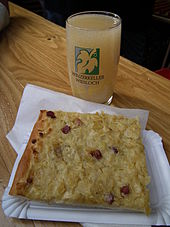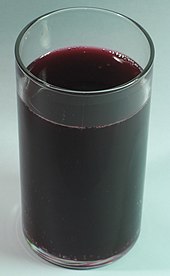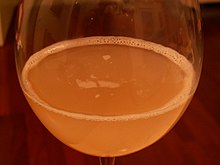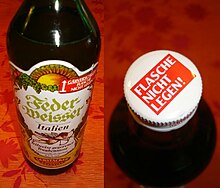New wine
New wine is not yet a finished wine , but grape must pressed from white or red grape varieties , the alcoholic fermentation of which has just started and which has not yet been subjected to filtration . Basically, all intermediate stages from grape must to almost fully fermented young wine are called new wine , which is later called white , red or rosé wine after fermentation is complete.
Regional names
In the wine regions of the German-speaking area, there are different names for new wine, some of which also denote different stages of maturity. Often reference is made to the color or to sensations on the tongue, in the head or in the digestive area. In Germany , a distinction is made between Federweißem (made from white grape must) and Federrotem (made from red grape must), in Austria all color variants of the new wine are called Sturm . In parts of southwest Germany , in Franconian wine-growing regions , in German-speaking Switzerland and in South Tyrol, it is called Suser or Sauser , on the Hessische Bergstrasse and in Rheinhessen it is called Rauscher , in the Palatinate mostly Neier Woi / Wei ("new wine") or Bitzler . In Franconia , the first, still sweet fermentation stages are called brakes . Elsewhere names such as young wine , riser , scabies , new sweet , dusty or dusty are common. In Italy it is called Vino Nuovo ("new wine"), in the French-speaking area it is called vin bourru (sullen wine). In the Czech Republic one says burčák [burt͡ʃa: k] ( bouře = storm - analogy to Austria), in Luxembourgish it is called Fiederwäissen .
Differences in the German-speaking area
Germany
In Germany are new wine or Bitzler common as common umbrella terms; Federweißer comes from white grape must, the newer variant Federroter from red. The next stage before the finished fermentation is called young wine for all grape varieties .
The German dictionary of the Brothers Grimm suspected around the middle of the 19th century that the name Federweißer derives from the old name Federweiß for alum , which was previously used as a preservative for wine. However, since such agents are only added in later stages of ripening, it is now assumed that the yeast cells , which the feather white contains as suspended matter like every new wine, gave it its name because of their feather white color. The name is declined like "the white one" ; so one drinks z. B. the feather white .
Austria
In Austria the terms new wine , Federweißer or Federroter are not used. According to the Austrian wine law, the partially fermented grape must is called Sturm, regardless of the color . He has some regional specialties with their own names:
The cloudy pink to violet-colored Schilchersturm is produced in Styria . This new wine is made from the Blauer Wildbacher grape variety , which is traditionally used to make the Schilcher rosé wine .
In Eastern Austria, a distinction is made between the dusty and the dusty , which represents the next stage of maturity from storm to wine tavern .
In southern Burgenland , the Uhudler , a light red to rosé blended wine made from certain grape varieties, is also offered as a (white, red or rosé) Uhudlersturm in its early stages .
Switzerland
In Switzerland , both the white and the red version of the new wine are usually called Sauser . There, Federweisser does not refer to a new wine, but to white wine or sparkling wine made from red grapes, i.e. the Blanc de Noirs .
Manufacturing
Grape varieties
Especially in early autumn, new wine is made from early ripening grape varieties such as Bacchus , Ortega or Siegerrebe ; Large producers sometimes use must from southern Europe, which is delivered in tank trucks. As autumn approaches and the grapes ripen, basically any grape variety can be used. Red new wine is mainly produced in classic red wine regions such as the Ahr , but also in other wine-growing regions . As early-ripening red varieties, Frühburgunder or Dornfelder are particularly suitable .
fermentation
Grape must begins to ferment quite quickly due to the naturally contained or added yeast and depending on the storage temperature. The sugars glucose and fructose from the grapes are split into alcohol and carbonic acid ( glycolysis and fermentation). As a rule, only those grapes are processed into new wine that do not have the potential to be fermented into a high-quality and storable predicate wine .
marketing
The new wine can be sold from an alcohol content of around 4%. It continues to ferment until most of the sugar it contains has been converted into alcohol, at which point it has an alcohol content of around 11%.
Due to the rapid fermentation process, the new wine can only be stored for a short time, even if it is cooled; it should be used up after a few days. Because new carbon dioxide is constantly being formed, the vessels must not be hermetically sealed, otherwise they would burst. As the open vessels could only be stored upright and fermentation could not be delayed due to the lack of effective cooling, transport over longer distances was previously not possible. New wine was therefore almost exclusively known in the wine-growing regions.
There it is still sold directly by the vintner in the street, and the majority of the early wine festivals take place there . B. in the Palatinate are sometimes known as "Bitzlerfeste". The two largest German events of this kind, in which not only the mature but also the new wine plays a role and the number of visitors goes into the hundreds of thousands, are the German Wine Harvest Festival in Neustadt an der Weinstrasse with the election of the German Wine Queen and the Festival of Federweiss in Landau in the Palatinate , where the new vintage is baptized .
Depending on the start of the grape harvest, new wine is offered from the beginning of September to the end of October. By storing harvested grapes in a cool place and processing them later, some winegrowers extend the sales period into November or even December. In Austria, according to the Wine Act , the Sturm can be sold from August 1st to December 31st and must have an alcohol content of at least 1%.
enjoyment

Because of the carbonic acid produced during fermentation, new wine tastes very tangy, initially like a kind of grape lemonade or a sweet sparkling wine. As long as there is still plenty of sugar, its sweetness conceals the alcohol that has already formed, so that it is absorbed into the organism relatively unnoticed when drinking. Therefore, the intoxicating effect of the new wine is often only registered with a delay or not at all. Due to the higher content of tannic acids, new red wine always tastes a bit tart than the white wine produced analogously. The new wine also contains lactic acid bacteria and a high proportion of vitamins B1 and B2 . It has a strong effect on the function of the intestine , especially on its peristalsis .
Web links
Individual evidence
- ↑ New wine. Retrieved on March 22, 2020 (German).
- ↑ Norbert Tischelmayer: Federweißer. (No longer available online.) Formerly in the original ; Retrieved September 9, 2011 . ( Page no longer available , search in web archives )
- ↑ a b § 7 Austrian Wine Law.
- ^ Fridolin Landolt: Federweisser. (No longer available online.) Archived from the original on July 27, 2011 ; accessed on September 9, 2011 (menu item wine glossary ).




